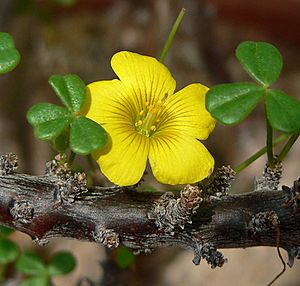Oxalis gigantea facts for kids
Quick facts for kids Oxalis gigantea |
|
|---|---|
 |
|
| Scientific classification | |
| Genus: |
Oxalis
|
| Species: |
gigantea
|
Oxalis gigantea is a special type of plant, a shrub, that grows in the dry regions of Chile. You can find it in the Antofagasta, Atacama, and Coquimbo areas. This plant is known for its tall, woody stems and bright yellow flowers.
Scientists first described Oxalis gigantea in 1845. It has a unique way of being pollinated: tiny, fast-flying hummingbirds help its flowers make seeds. In Chile, people often call this plant churqui or churco.
Contents
What is Oxalis gigantea?
Oxalis gigantea is a shrub, which means it's a woody plant smaller than a tree. It can grow quite tall, sometimes reaching up to 3 meters (about 10 feet) high! Its branches are often tangled and can look a bit spiky. The plant has small leaves and many bright yellow flowers that bloom in clusters.
Where does it grow?
This plant is native to the northern and central parts of Chile, a country in South America. It thrives in dry, desert-like areas, often on hillsides or in valleys. The regions of Antofagasta, Atacama, and Coquimbo are known for their very dry climates, but Oxalis gigantea has adapted to these tough conditions.
How does it reproduce?
Like many plants, Oxalis gigantea makes seeds to create new plants. But it needs help to do this! Its bright yellow flowers are designed to attract hummingbirds. When a hummingbird sips nectar from a flower, it accidentally picks up pollen. As the bird visits other flowers, it carries the pollen, helping the plant to reproduce. This process is called pollination.
Why are hummingbirds important?
Hummingbirds are very important for Oxalis gigantea. They are the main pollinators for this plant. Without these tiny birds, the plant would have a much harder time making seeds and growing new plants. This is a great example of how plants and animals depend on each other in nature.
See also
 In Spanish: Churqui para niños
In Spanish: Churqui para niños

